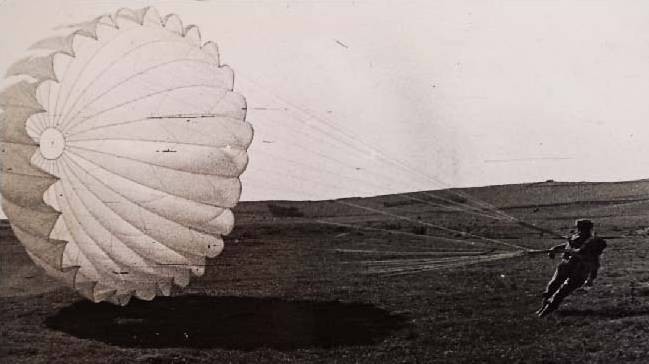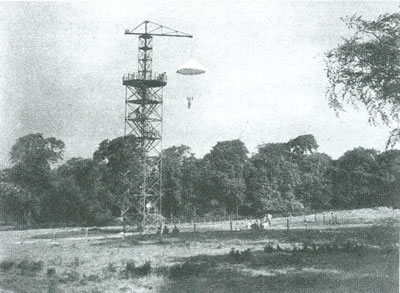The 1st Independent Polish Parachute Brigade
(1 Samodzielna Brygada Spadochronowa)
The Poles Background
In Parachuting
 © Fife Cultural Trust, Fife Council
© Fife Cultural Trust, Fife Council
Before 1939 in Poland, parachute training already existed.
It was introduced by Liga Obrony Powietrznej i Przeciwgazowej in multiple locations within Poland. Historical records show that in 1937 Liga Obrony Powietrznej i Przeciwgazowej put on an event that had well over 100,000 spectators who came to watch the parachutists descend.
Initially, it was regarded as a popular Polish sport but in 1936 it was catching the eye of the Polish military who were seeing the tactical possibilities and had already commenced a physical training program for parachuting.
At that point Parachute descent towers were designed so that the recruits could learn how to descend and land.

By 1937 the polish military had developed parachute courses covering physical training, descent, overcoming fear, developing courage and of course completing military missions.
The following year a test exercise was done and Polish parachutists managed to land in enemy territory carrying out subversive acts by destroying power installations, travel networks and communications.
So efficient were these recruits that by spring 1939 a PTC (Parachute Training Center) or as it is known in Polish "Wojskowy Osrodek Spadochronowy" ("WOS" for short) had been established at Bydgoszcz. Initially, a mere 80 recruits went through the course.
However, upon the Germans invading west Poland in Sept 1939, the PTC ended up getting abandoned and parachute training as such ended in Poland.
Some of the recruits headed west to fight in France, which coincidentally is where General Sikorski was starting to form a Polish Army.
General Sikorski now had a problem. He needed his troops in France and the ones in Poland to be in constant contact with each other and himself. Sending a messenger overland was not an option, so he happened upon the idea of using parachutists to deliver messages.
So around November 1939 onwards he decided to carry this out, however obtaining aircraft to carry this out was proving impossible. The France collapsed and Sikorski ended up having to evacuate the Polish Army as well as the Polish Government to the UK.
Meantime, in the United Kingdom, Prime Minister Churchill ordered the British Army to start training parachutists. It was at this point he formed the SOE (Special Operations Executive).
The one decision coupled with the other then allowed for parachute training of Polish soldiers (formerly exiled in the USSR) to commence.
The objectives of the Polish parachutists were:
- To organise and train parachutists for land combat in Poland (i.e the Warsaw Uprising)
- To ensure continuity of communications and assist A.K (Armia Krakowa) i.e "The Polish Underground"
You can read more about what was going on in this time period here.
Although General Sosabowski is widely regarded as being the founder of the 1st Independent Polish Parachute Brigade, this is up for question as on 14 October 1940 General Sikorski proposed "to prepare as large a part as possible of the Polish Army for the possibility of being transported by air to Poland to give direct support and protection to the Polish uprising".
It looks likely that General Sosabowski was merely acting on Sikorski's instructions and vision, however it is notable that on 4 October 1940, prior to Sikorski's announcement above, Geneal Sosabowski ordered "In connection with planned parachute training courses for soldiers of the Polish army in England, please supply a list of candidates for such courses, both officers and other ranks, by the 8th instant 12:00 hours".

It was at this point the call went out to the Polish soldiers in transit in the Middle East for Polish recruits.
General Sosabowski then recruited 2 of the instructors from the Polish Parachute tower in Bydgoszcz who by now were instructors at RAF Ringway. These 2 instructors (Leuitenant Jerzy Gorecki and Leuitenant Julian Gebolys).
A group of trained parachutists from RAF Ringway were then sent on a mission by Sosabowski, however the mission failed and the plane crashed. It was at this point that the story in Fife takes up with the 4th Rifle Cadre Broigade (stationed at Largo House) being sent down to RAF Ringway for training.
So, to cap, General Sosabowski had already had involvement with parachute training and parachutist missions from RAF Ringway, all this happened prior to him coming up to Fife (A fact no in many history books).
It would appear that the first parachute training tower in the UK was the one at Lundin Links, Fife. Later on, another one was built at RAF Ringway.
If my interpretation of facts is correct, this means the first recruits at RAF Ringway (circa 1940) did not have a tower to practice from so must have used other methods.
History books then state that what was learned on building the towers was then taken back to Poland, however I beg to differ as there is no evidence of this.
On 23 September 1941 the 4th Cadre Rifle Brigade (4th CRB) was renamed "1st Parachute Brigade". On 20 October 1942 this was officially changed to "1st Independent Parachute Brigade".
Please Donate!

Uncover The Past - Support The Future
Please don't "grab & go"! Each year, 12,000 people visit this website to trace their Polish ancestry, uncover family stories, and connect with their roots. I believe that history should be accessible to all - but keeping this website alive since 2017 comes at a personal cost to me, 8 years @ £1000 per year (website mgt fees) has left an £8000 dent...with only £380 in total donated up to 27/11/25 😱😱😱.
Every detail you uncover and every story you piece together helps you piece family history together. Please donate if you found the existing information on this site useful, help me keep the site alive! Thanks! Jason Nellyer (Researcher & Site Owner)